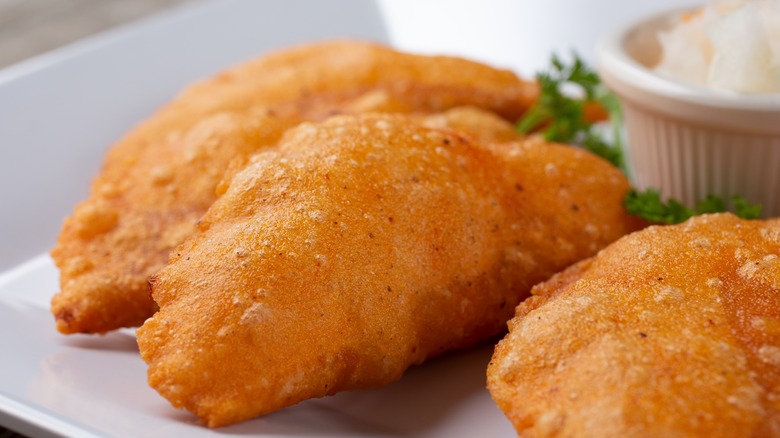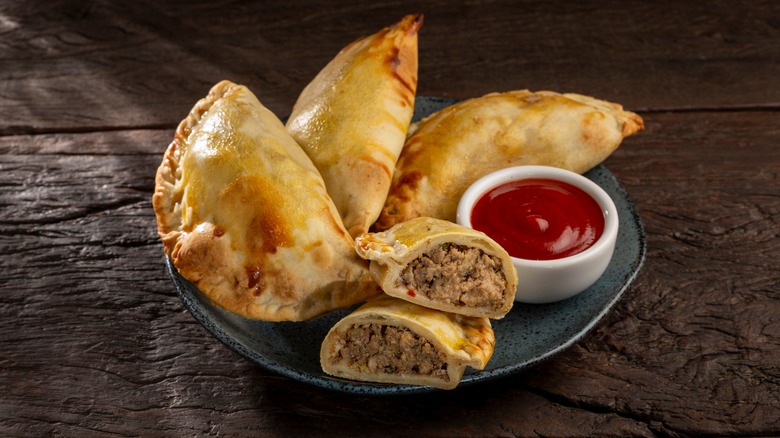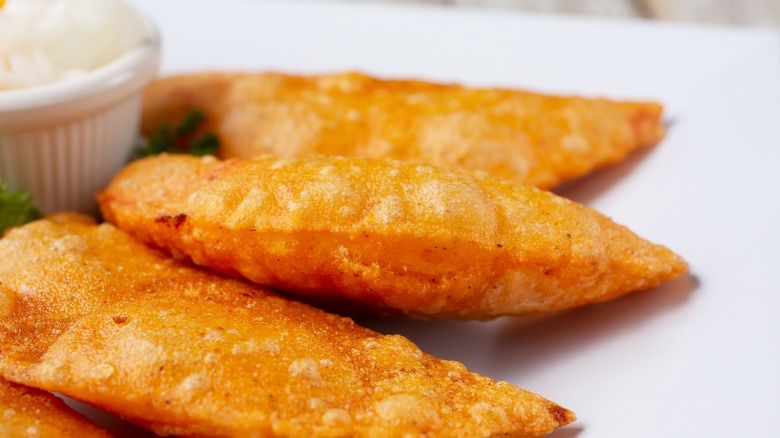How Belizean Panades Differ From Empanadas
Sing along with us, "Sing a song of sixpence, a pocket full of rye, four and twenty blackbirds, baked in a pie, when the pie was opened the birds began to sing, wasn't that a dainty dish to set before the King." On the surface an innocent nursery rhyme, but the lyrics go much deeper. These "live" pies were a way royalty long ago impressed their guests, according to the Library of Congress. The story of pies is actually present in almost all of cultural history, starting with the ancient Greeks and Egyptians, as the Library of Congress outlines its lineage.
Then there's the individual serving version of pie. Whether you call them hand pies, pasties, samosas, or even empanadas, you'll likely find some version of them anywhere you travel in the world. In the United States, they were an OG of fast food as a quick meal for immigrants building America's infrastructure, according to PBS. And, when it comes to empanadas, the pies have a migratory history all their own. So, when empanadas showed up in the Americas through quite a violent passage, panades eventually became a Belizean staple. And, in this instance, the chicken or the egg origin question has a clear answer. But, how do the two pies differ?
Empanadas
Just as not all whiskies are bourbons, not all empanadas are panades. In fact, MasterClass lists four primary types of empanadas to include the Belizean panade. The outlet describes an empanada as basically handheld pies stuffed with meats such as chicken, beef, fish, and chorizo. Or, you can opt for vegetarian empanadas filled with sweet potatoes, peppers, or even guava.
As its name is derived from the Spanish word empanar which means to wrap in bread, according to Majur Primary School, any empanada worth its weight highlights the maker's bread of choice. You can choose to spruce up a store-bought pie dough. But, for an authentic empanada, you'll make the pie dough from scratch using ingredients such as all-purpose wheat flour, corn flour, or even cassava depending upon the region your empanada originates, as Master Class notes.
While the empanada originated in Spain and Portugal, Majur explains that the pies made their way to the Philippines and Latin America via Spanish colonists. Upon the colonists' arrival, the Indigenous people of the Americas faced an entirely different food system that included a more meat-heavy diet as a result, per Food is Power. And, even as the colonization mandated wheat to be grown, as opposed to indigenous ancient grains, per Cornell Botanic Gardens, empanadas were about to face a cultural shift of their own – one of a different grain.
Panades
If food serves as an important symbol of personal and cultural identity as JSTOR suggests, corn is part of that equation for Belizeans. Adjacent to Guatemala, the Central American country's original inhabitants were Mayan centering their daily lives around corn including prayers to their Maize God, per My Beautiful Belize.
So, it stood to reason that the Belizeans would put their spin on the traditional Spanish empanada starting with the dough made from the grain of their people – corn, or masa if you want to get technical. This dough made from fresh-ground cornmeal is mounded upon a tortilladora and pressed super thin, as Caribbean Lifestyle explains. But, unlike a tortilla which is cooked on a comal, the panades are deep fried. The outlet also notes they are typically stuffed with lighter fare such as beans or fish.
Another way panades separates its identity from the empanada is its cortido – a topping made from onions, vinegar, salt, and habaneros, as Untame Belize lists this snack staple a must-try when visiting Belize. A Belizean favorite among locals, folks have their opinions that can even show up in infographics dissecting their favorite components – masa wins hands down!
With just a few adjustments to a traditional empanada, consider the panade an ode to an entire culture's history. And, while food is something we all need to survive, knowing how it evolves and changes the narrative is where the true meat of the matter lies.


